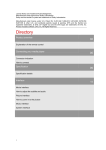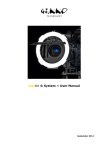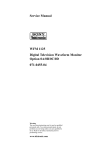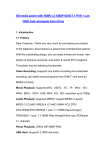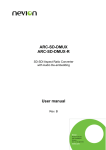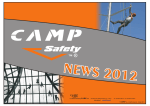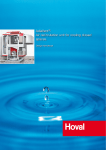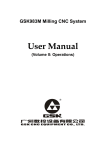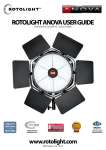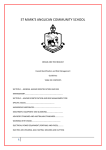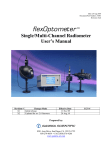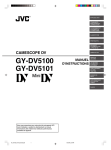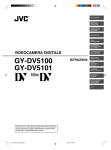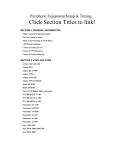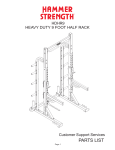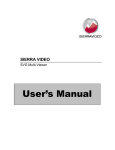Download digital cinematography camera system hd900f operation manual
Transcript
DIGITAL CINEMATOGRAPHY CAMERA SYSTEM HD900F OPERATION MANUAL HARDWARE VERSION /3 ULTRA PRECISION EQUIPMENT FOR THE MOTION PICTURE INDUSTRY written by Eric Erb Andrew Young design, photos, and layout Eric Erb Andrew Young photographs were shot using the Kodak Preview System with Primo lenses HD900F OPERATION MANUAL COPYRIGHT 2002 VERSION 3.0 May 2004 2 HD900F INTRODUCTION INTRODUCTION In 1997, Panavision and Sony announced their collaboration on the development of a 24P digital high definition camera suitable for use by filmmakers to create big screen motion picture image quality. We knew, from 45 years of experience, that a complete imaging system approach was the only way for traditional film crews to make a seamless transition into digital production. With this in mind, we made a number of modifications to the Sony HDW-F900 24P camera. For starters, the Panavised camera received a heavy duty front plate and lens mount modified to work with our specially designed Primo Digital® lenses. The system now accommodates most of our standard film camera accessories as well as new accessories designed exclusively for digital cinematography. In addition to the mechanical modifications to the camera, a unique optical pre-filter gives you better color matching with film emulsions and enhanced resolution for blue screen effects cinematography. Last, but not least, we designed the new ULTRAVIEW viewfinder for studio and handheld cine-style use. It presents a 2 times larger image along with a greater diopter range. Panavision is committed to continuously developing our Digital Imaging system in close collaboration with our clients, just as we have done with our film systems over the last 45 years. Now your HD project will benefit from the same dedication to customer service and superior image quality that is the hallmark of Panavision. 3 TABLE OF CONTENTS SECTION 1.0 1.1 1.2 1.3 1.4 1.5 1.6 1.7 1.8 1.9 GENERAL SPECIFICATIONS CAMERA SPECIFICATIONS CONNECTOR SPECIFICATIONS FRAME RATES AND SHUTTER SPEEDS CAMERA WEIGHTS CAMERA MEASUREMENTS SIDE CAMERA VIEWS FRONT AND REAR CAMERA VIEWS PROGRESSIVE VS. INTERLACE GENERAL IMAGING CONSIDERATIONS SECTION 2.0 2.1 2.2 PACKING AND SHIPPING CAMERA BODY CASE ACCESSORY CASE SECTION 3.0 PRIMO DIGITAL® LENSES 3.1 3.2 3.3 PRIMO DIGITAL® LENS DESIGN FILM / HD COMPARATIVE RESOLUTION ASPHERICAL AND FISHEYE ATTACHMENTS 3.4 3.5 PRIMO DIGITAL® LENS EXTENDERS SETTING BACK FOCUS SECTION 4.0 4.1 4.2 4.3 4.4 4.5 4.6 4.7 4.8 4.9 4.10 4.11 44 CAMERA ASSEMBLY FRONT FACEPLATE AND FOLLOW FOCUS VIEWFINDERS ON-BOARD MONITORS AND BRACKET LENS LIGHT VOLTAGE UPCONVERTER CARRY HANDLE SIDE PANEL CONNECTORS MIRANDA DOWNCONVERTER REAR PANEL CONNECTORS HD SDI ADAPTER ON-BOARD BATTERIES CAMERA OPERATION HDCAM CASSETTE VTR CONTROLS VIEWFINDER CONTROLS REMOTE CONTROL FILTER WHEELS MEMORY STICK TIMECODE TIMECODE SWITCHES AND BUTTONS USING TIMECODE MAIN CAMERA SWITCHES MENUS USER MENU OPERATION MENU PAINT MENU SETTING THE FRAME RATE VIEWFINDER FRAMELINE MARKINGS TV 16X9 TRANS & 4X3 TRANS / SAFE TV 16X9 TRANS & 1.85 THEATRICAL TV 16X9 TRANS & 2.40 THEATRICAL PREP ROUTINE A.C. PRE-ROLL CHECKLIST PRODUCTION CONSIDERATIONS TROUBLESHOOTING SMART LENS METADATA SECTION 6.0 6.1 6.2 6.3 6.4 6.4.1 6.4.2 6.5 MONITORS MONITORS 9" HD SDI MONITOR 14" HD SDI MONITOR 20" & 24" HD SDI MONITOR 20" & 24" MONITOR CALIBRATION 20" & 24" MONITOR FRAMELINE SETTINGS HD SDI WAVEFORM MONITORS SECTION 7.0 INDEX TABLE OF CONTENTS SECTION 5.0 5.1 5.2 5.3 5.4 5.5 5.6 5.7 5.7.1 5.7.2 5.8 5.9 5.9.1 5.9.2 5.9.3 5.9.4 5.10 5.10.1 5.10.2 5.10.3 5.11 5.12 5.13 5.14 5.15 5.16 HD900F TABLE OF CONTENTS 5 6 HD900F 1.0 GENERAL SPECIFICATIONS 7 GENERAL SPECIFICATIONS 1.0 1.1 CAMERA SPECIFICATIONS Imager RGB 2/3" CCDs Effective Pixels 1920 (H) x 1080 (V) each 2.1 million pixels each, 6.3 million total .378" x .212" Power 12 v DC (range 11-17v) Built-in Filters ND Filters 1: Clear 2: .6 - (2 Stops) 3: 1.2 - (4 Stops) 4: 1.8 - (6 Stops) 88 CC A: B: C: D: Filters 5600K 3200K 4300K 6300K Lens Mount Panavision HD Mount (proprietary) Baseplate Panavision Dovetail with 5/8" rods Steadicam® Plates Bottom Dovetail Plate for Regular Mode Top Handle Plate for Low Mode Sensitivity Minimum ISO 320 tungsten Cassette Tape HDCAM: BCT-22HD, BCT-32HD, or BCT-40HD Running Times 22 min. @ 30 fps or 27.5 min. @ 24fps 32 min. @ 30 fps or 40.0 min @ 24fps 40 min. @ 30 fps or 50.0 min. @ 24fps Audio Quality 20 bit, 48kHz Digital (up to 4 channels) Preset Storage Sony Memory Stick Eyepiece Panavision Ultraview® - 2 modes: Extension and Intermediate / Hand-held or Ultraview® Color Viewfinder SMARTLENS™ Compatibility High resolution digital encoders to record T-stop, focus, and zoom positions HD900F 1.2 CONNECTOR SPECIFICATIONS DC out Hirose, 12V DC, 4 pin (2 A max) REM Lemo, 10 pin 1B Pin 1 - VTR Start / Stop Pin 6 - Ground VTR, shutter, menu controls (HDRP) Audio In 2 Channels – XLR, 3 pin female Pin 1 – Ground 2 – Input (hi) 3 – Input (low) 2 additional channels with HDSDI adapter (HDCAA) Mic In 1 Channel – XLR, 3 pin female (+48v) Pin 1 – Ground 2 – Input (hi) 3 – Input (low) Audio Out 2 Channel on 1 – XLR, 5 pin male (E-E) Pin 1 – Analog Ground (shield) 2 – Ch. 1 Output (hi) 3 – Ch. 1 Output (low) 4 – Ch. 2 Output (hi) 5 – Ch. 2 Output (low) 2 additional channels with HDSDI adapter (HDCAA) Genlock In BNC Genlock Out BNC (using analog Y channel) Timecode In BNC Timecode Out BNC Video Out Y, Pb, Pr Analog HD SDI (with HDCA adapter) Remote Control Hirose (special) – 8 pin 9 1.1/2 GENERAL & CONNECTOR SPECS XLR, 4 pin male 11-17 v Pin 1 – ground (-) Pin 4 – positive (+) GENERAL SPECIFICATIONS DC In 1.3 FRAME RATES AND SHUTTER SPEEDS Frame Rates (MAINTENANCE MENU page: M7) Progressive 23.98 PsF 24 PsF 25 PsF 29.97 PsF 30 PsF Interlace 50i 59.94i 60i Shutter Angles (PAINT MENU page: P12 Control) SHUTTER SPEED Shutter OFF = 1/24 sec 1/32 1/48 1/96 1/125 1/250 1/500 1/1000 or with the Remote EQUIV. SHUTTER ANGLE 360.00 degree 270.00 180.00 90.00 69.12 34.56 17.28 8.64 ECS - Extended Clear Scan 24 Hz - 2200 Hz @ 24fps Used to set intermediate shutter speeds and / or shoot practical monitors. The equivalent shutter angle, for a film camera, is found by the following formula: 360 * fps / Hz = shutter angle. 10 10 Body (without SDI) HD900F 14.9 lbs. Body (With SDI) HD900F, HDCA 17.2 HDCA 2.3 HDET, HDEP 4.8 Intermediate / HH Eyepiece HDEP 3.6 Follow Focus w/1 Knob HDFB, HDFD, MFF 1.9 Hand Held Rig HDHR 2.4 Clip-on Mattebox MBPC 1.0 HDLM 0.5 Top Steadicam® Bottom Plate Steadicam® HDSP 1.2 Voltage Upconverter w/cable Plate HDUC 0.9 Anton Bauer Battery AB100 5.4 SD5 3.0 GENERAL SPECIFICATIONS SDI Adapter Extension Eyepiece HD900F 1.4 CAMERA WEIGHTS LENSES Primo Digital® 5mm Prime Lens 7mm Prime Lens SD7 3.2 Primo Digital® 10mm Prime Lens SD10 3.7 Primo Digital® 14mm Prime Lens SD14 2.8 Primo Digital® 20mm Prime Lens SD20 3.6 Primo Digital® 35mm Prime Lens SD35 2.9 Primo Digital® 6-27mm w/Motor SDZW 8.0 Primo Digital® 25-112mm w/Motor SDZT 7.0 Primo Digital® 9.5-105mm w/Motor SLZ11D 23.0 SDZ9 8.6 Primo Digital® 8-72mm w/Motor 1.4X Extender for Primo 2X Extender for Primo Digital® Digital® Zoom 1.4XSD Zoom 2XSD 0.7 0.9 Double Asphere Attachment for 5mm CDA 1.2 Wide Angle Fisheye Adapter for 7mm WFA 1.4 Hand Held Configuration: 1.3/4 FRAME RATES & CAMERA WEIGHTS Primo Digital® 29.3 (Hand Held Viewfinder, SDI, HDUC, Follow Focus w/1 Knob, HDHR, MBPC, Remote – No Lens) 11 12 HD900F 1.5 CAMERA MEASUREMENTS GENERAL SPECIFICATIONS 1.5 CAMERA MEASUREMENTS 13 14 HD900F 1.6 SIDE CAMERA VIEWS GENERAL SPECIFICATIONS 1.6 SIDE CAMERA VIEWS 15 16 HD900F 1.7 FRONT AND REAR CAMERA VIEWS GENERAL SPECIFICATIONS 1.7 FRONT AND REAR CAMERA VIEWS 17 Static Interlaced Image consists of two fields Moving image appears to the eye as a blurred, broken edge 18 Field 1 (odd lines 1,3,5, etc.) Field 2 (even lines 2,4,6, etc.) 60 field to 24 frame conversion requires the mixing of 3 fields resulting in additional motion blur HD900F 1.8 PROGRESSIVE VS. INTERLACE INTERLACE: GENERAL SPECIFICATIONS The 24P HD Electronic Cinematography Camera System is a PROGRESSIVE capture device unlike older video cameras that capture the image in an INTERLACE manner. A video scanning system where the odd numbered lines are scanned separately from the even numbered lines. The odd numbered lines form field one, the even lines make up the second field. The combination of two fields comprises one frame. PROGRESSIVE: A video system in which all lines comprising a frame are scanned in sequence rather than interlaced. The interlace mode of capture has inherent motion artifacts and is difficult to transfer to film. The progressive mode of shooting captures the complete resolution at once, at the same point in time; and therefore allows a perfect one-to-one transfer to film. 1.8 PROGRESSIVE VS. INTERLACE 19 1.9 GENERAL IMAGING CONSIDERATIONS The HD900F has a wide range of menu settings that allow the user to control the look of the picture. These settings can be a powerful tool to change or modify the captured image. Most components of the video signal can be manipulated. Levels, saturation, gamma and matrix will have a major influence over the final video output, be it for TV or film. While there is no right or wrong way to approach how the camera is used, you should be aware of the consequences of employing certain menu functions. We do not determine who will make adjustments or when these functions will be employed, but in most cases, they are made at the behest of the DP. While these features may prove useful for shows that are video out only (TV), if misused, they can have irreversible consequences on a film-out show (feature). Judicious use of these features can prove beneficial. However, minimum manipulation of the image that will result in a clean camera master is desirable. It is better to leave the decision to alter the image for the less stressful environment of the post production suite. Post production tools offer the ability to manipulate the image to a much higher degree than the camera allows. The following list is not inclusive of every menu function, but provides a brief explanation of why certain precautions should be heeded. Detail: The detail function will provide artificial enhancement to the video image particularly around the edge of an object. This feature, like several others, is incorporated into the camera for live TV broadcast productions. Historically, detail circuits were used to compensate for limitations of optics or electronics. While this is useful for TV applications, employing detail for a film output production will put unnatural edging around the subject. In addition, use of detail will make the quality of CGI or mattes very poor since the matte process tries to avoid any appearance of edges. DCC: DCC is Dynamic Contrast Control, or Auto Knee. It is accessible through a toggle switch on the side of the camera body which also controls bars on and off. This operation intelligently monitors the brightness of all areas in a scene, and automatically adapts the knee point and slope for optimum reproduction at that particular scene location within the picture. This is preferred to clipping or losing information, the DCC can automatically pull the level down (compress) so the highlight will not "blow out". A classic example is shooting an interior scene which includes a bright sunlit exterior seen through a window. Some breathing can still be seen using the DCC circuit if a bright object enters the frame, if this is objectionable please use the manual knee. Knee Saturation: This function makes it possible to reproduce natural colors in a scene where knee is used. When knee correction is added to a scene, it can lead to color desaturation in highlight areas. Knee Saturation can automatically retain correct color in these areas and maintain the saturation in those picture areas compressed by the knee function. Flare: Electronically corrects for light transmission problems in a lens. As light is transmitted through glass the rays are scattered and the image is perceived to have less contrast. Flare can correct this by automatically balancing the black levels. Because of the superior performance of the Panavision lenses, flare control is not needed. 20 20 HD900F 1.9 GENERAL IMAGING CONSIDERATIONS Clear Scan and ECS (Extended Clear Scan): This function eliminates the banding effect when shooting a monitor display by allowing the shutter speed to be adjusted so that it exactly matches the scanning frequency that are in use. The Clear Scan shutter speed range is from 24.00 to 2200 (1080/ 23.98psf), 30.00 to 4300Hz (1080/59.94i mode). The ECS function is especially effective under 60 Hz. GENERAL SPECIFICATIONS Black Gamma: This circuit allows for stretch or compression of the toe (black) portion of the video signal. This can be used to affect the contrast in the dark areas of the picture while not changing the mid-tones or highlights. Since this portion of the signal contains the highest amount of gain, it is closest to the noise floor. Consequently, expanding the signal will also introduce more noise into the picture. This may not always be a desired addition to the final look. For a film-out project, testing is prudent. Matrix: The matrix is a series of mathematical calculations that are applied to the color output of the camera. Its purpose is to match the color space of the camera to the final display device. It is similar to certain equalization curves that are employed in the recording industry to ensure that the playback system will reproduce the original recording faithfully. In the video world, matrix is used to provide a set of equations that relate to the reproducing characteristics of various sets of phosphors that are used in TV picture tubes. This function (like others on the camera) has roots in the early days of color television when technology and economics determined that some circuits would be placed in the camera and others in the receiver. As with detail, matrix can prove useful for a broadcast or video only production. Use of the matrix for a film-out production is cautioned since the film-out device will not be able to recreate the proper color space from the camera to match the film emulsion (the equation is no longer valid). If color manipulation is desired, it is recommended that one shoot a test using the matrix to create the appropriate look. This test can be used as a guide for the facility that will be doing the film-out. Due to inherent differences in imaging characteristics between a CCD, a monitor, and the human eye, certain translations are necessary. The Gamma and Matrix settings interpret the CCD image so that the monitor image will approximate the actual subject. Gamma should always be turned ON and set to COARSE 0.45, TABLE STANDARD 5. This references the ITU REC 709 standard. This gamma correction is especially important for video output, and can be manipulated for film output, and so should be left on all the time. (see section 5.9.3) 21 1.9 GENERAL IMAGING CONSIDERATIONS Use of the camera in the preset modes will produce perfectly good images that can be manipulated with a much higher degree of control in the post environment. In short, you do not need to have a comprehensive knowledge of the paint menu to produce a good image. Again, there is no right or wrong way, but this manual addresses those features that are necessary for a camera assistant to master. 1.9 GENERAL IMAGING CONSIDERATIONS Shooting 24P for Film output: Since the HD monitor is much closer to the final video image, but only an approximation of the film image, there are some recommendations in order to maximize quality of final film output: - GAMMA ON as above MATRIX OFF GAIN set to 6dB or less, to avoid adding excessive noise to final image. Use less diffusion. Consider using a filter of 1/2 the value used with film negative. DETAIL OFF This is especially important because it will degrade the film output. FLARE OFF We caution against using paint menus for image manipulation if finishing on film because the monitor image and paint effects do not directly correlate to the film image, and they are usually irreversible. Shooting 24P for Video output: (No future film-out foreseen or planned) When shooting for video finish, the HD monitor is in effect your final image. Therefore adjustments can be made in the camera with more confidence in the intended results. Standard recommended settings are: - GAMMA ON as above MATRIX ON, PRESET ON, ITU-709 USER MATRIX OFF MULTI-MATRIX OFF GAIN set to 6dB or less. FLARE OFF All the paint adjustments can be set for creative effect, but the user must be aware that many settings cannot be undone in post. On the other hand, if the camera image is recorded clean, many powerful creative manipulations are available in the color correction stage. NOTE: The MATRIX must be OFF for blue or green screen shots because it may create undesirable artifacts. NOTE: To restore the paint menus to their Panavision default settings, recall the STANDARD file on menu page P13, by clicking on it twice. 22 22 HD900F 2.0 PACKING AND SHIPPING 23 PACKING AND SHIPPING 2.0 24 HD900F 2.1 CAMERA BODY CASE The HD900F camera system is comprised of 2 cases, one containing the camera body and the other containing the camera accessories. The camera is stored without the eyepiece attached. PACKING AND SHIPPING Included with the camera is an AC to DC power converter (HDPS) with 2 24V DC and 2 12V DC outputs for camera and accessory power. CASE CONTENTS: HD900F HDEP HDET HDVP HDCA or HDCAA HDUC HDRP HDPCM ABGM or IDXA HDPS CBLE-IECNA CBLE-12P (2) Camera HD900F HD Ultraview® Viewfinder HD Extension Tube HD Viewfinder Pivot HD SDI Cam Adapter (data or audio) HD Accessory Voltage Upconverter HD Remote Control Panel HD Camera Mount AB Goldmount or IDX Battery Adapter HD 24/12DC Power Supply IEC/N. America Mains Plug 12V Power Cable (XLR4) 2.1 CAMERA BODY CASE 25 26 HD900F 2.2 ACCESSORY CASE Clip-on polarizer matte box is optional. CASE CONTENTS: MFFGB MFFSK (2) MFFEX FXHL FFX EPL-M PLL HDLM HDSP HDRB CBLE-ZLP (2) IRISROD Modular Follow Focus Gear Box Modular Follow Focus Single Speed Knob Modular Follow Focus Extension Offset Handle Follow Focus Extension 12" Eyepiece Leveler - Millennium Panaflex Lens Light HD Low-Mode Bracket HD Steadicam Plate HD Rod Bracket Zoom Lens Power Cable Pair of 10" Irisrods PACKING AND SHIPPING The accessory case holds a 4x5 swing away matte box with mattes, sunshade, follow focus and knobs, Panavision Steadicam plates, eyepiece leveler, lens light, whip, follow focus bracket, and side rod adapter. 2.2 ACCESSORY CASE 27 28 HD900F 3.0 PRIMO DIGITAL® LENSES 29 PRIMO DIGITAL® LENSES 3.0 ® 30 HD900F 3.1 PRIMO DIGITAL® LENS DESIGN Primo Digital® Lenses were designed specifically for the 2/3” CCD imager to optimize image quality. They are not modified cine lenses. However, Primo Digital ® primes and zoom lenses fully incorporate the optical, mechanical and ergonomic characteristics of our Primo cine lenses with additional features to enhance electronic cinematography. • • • • • • PRIMO DIGITAL® LENSES • High contrast and resolution for maximum sharpness. 2.5 times that of our cine Primo lenses to accommodate the 2/3” imagers. Optimized for maximum image quality at fast maximum apertures of T1.6 – 1.9 (f1.45 – 1.75), thus enabling depths of field similar to 35mm cine formats. Very low veiling glare, ghosting, lateral color and distortion. Dual expanded, calibrated and accurate focus scales. Precision back focus adjustment – on all lenses including Digital Primes. Internal filter slot – to selectively control colorimetry and resolution/contrast. For use with the SMARTLENS™ system, Panavision lenses are available with integral encoders for display of focus, zoom and aperture position. PRIMO DIGITAL® LENSES: 5mm T1.8 Primo Digital® Prime 10½" CF SD7 7mm T1.6 Primo Digital® Prime 12" CF SD10 10mm T1.6 Primo Digital® Prime 12" CF SD14 14mm T1.6 Primo Digital® Prime 12" CF SD20 20mm T1.6 Primo Digital® Prime 13" CF SD35 35mm T1.6 Primo Digital® Prime 20" CF SDZW 6-27mm T1.8 Primo Digital® Zoom 22" CF SDZT 25-112mm T1.9 Primo Digital® Zoom 32" CF SDZ9 8-72mm T1.9 Primo Digital® Zoom 3' CF SLZ11D 9.5-105 T1.6 Primo Digital® Zoom 4¼' CF 1.4SXD 1.4X extender for Primo Digital® Zoom 2XSD 2X extender for Primo Digital® Zoom CDA Double Asphere Attachment, 5mm = 4mm WFA Wide Angle Fisheye Adapter for 7mm 3.1 PRIMO DIGITAL® LENS DESIGN SD5 31 3 perf 16x9 35 mm film area 2/3” HD CCD 20 cycles / mm 32 50 cycles / mm HD900F 3.2 FILM / HD COMPARATIVE RESOLUTION PRIMO DIGITAL® LENSES The 2/3" CCD imager is actually only 11mm in diagonal (as opposed to the 27.5mm diagonal of a 35mm motion picture film frame). Therefore, for any given screen size, the 2/3" CCD will require 2.5 times more horizontal magnification than a 35mm film frame. This required that our new Primo Digital® lens series be designed to have 2.5 times the performance of our best cine lenses. All of the new Primo Digital® lenses provide their optimum performance at their maximum aperture. On the left side of this graphic is a 16x9 format, 35mm film camera aperture. On the right side is the image area of a 2/3" CCD drawn to the same scale. In order to have the same performance as a Primo cine lens, Primo DigitalTM lenses achieve 80% contrast at 50 line pairs per millimeter on the 2/3" CCD (2.5 times better frequency response). 3.2 FILM / HD COMPARATIVE RESOLUTION 33 3.3 ASPHERICAL AND FISHEYE ATTACHMENTS 34 34 HD900F 3.4 PRIMO DIGITAL® LENS EXTENDERS PRIMO DIGITAL® LENSES 3.3/4 ATTACHMENTS & EXTENDERS 35 INTERNAL FILTER SLOT BACK FOCUS LOCK BACK FOCUS ADJUST RING 36 HD900F 3.4 SETTING BACK FOCUS In order to gain the maximum performance from any lens, it is necessary that back focus be adjusted. Using a lens that is not properly adjusted will result in soft (out of focus) images. While lenses for motion pictures have a fixed back focus that is adjusted by a service technician, lenses for video employ an integral adjustment that is set by the user. PRIMO DIGITAL® LENSES WARNING : Be aware that extreme temperature changes can affect camera parameters such as black balance and back focus. Check the lenses after every lens change and after they have “warmedup” on the camera. Also, you MUST check and/or readjust back focus when switching lenses on different cameras. Setting back focus is a simple process and once a few steps are practiced, it can be performed quickly. Test equipment : It is helpful to have a chart that contains high frequency (fine vertical lines) information. As an alternative, look at a flat subject with fine detail (newspaper) and high contrast. 3.4 SETTING BACK FOCUS If you have a waveform monitor on the set, observe a properly focused image in the green channel. You should find this an aid to finding the proper setting. If you will be judging focus from a monitor, the 24” is best. The 14” will suffice, but do not use a 9” monitor for this procedure. The following steps describe the procedure for both zoom and fixed focal length lenses. 37 38 Zoom lenses : 1. Set the chart and the lens at a precisely measured close distance that coincides with an engraved mark on the focus scale. This mark should be no closer than the minimum focus plus 6" and no further than the ability to resolve fine detail on the chart. 2. Follow steps 2, 5, 6, and 9 above. Note: on wide angle lenses it may be difficult to confirm the distance scale by eye due to the extreme depth of field of a wide angle lens. 39 3.4 SETTING BACK FOCUS Fixed focal length lenses: PRIMO DIGITAL® LENSES 1. Set up a chart or flat test subject at around 4 – 6 feet from the focal plane. 2. Open the iris to the MAXIMUM aperture (T1.8, etc.). Use the incamera ND filters if necessary. 3. Set the zoom to the longest focal length (zoom in) and front focus the lens for the sharpest image. At this point you will find it helpful to adjust the camera viewfinder peaking control to a minimal amount of peaking. This will show very fine focus changes. It is sometimes helpful to turn off or lower the brightness on the viewfinder to emphasize contrast. Practice by observing the peaking while racking the follow focus slowly to find the sharpest point (peaking just on). 4. Now, set the lens to the WIDEST focal length (zoom out). 5. Unlock the back focus lock (just enough to move the adjustment ring). The lock is the ring located in front of the back focus adjustment ring. 6. Move the adjustment ring slowly while observing the viewfinder peaking, or the waveform monitor, or the picture monitor (24” preferably) for the best focus. Look at the finest detail that you can discern. 7. Again, set the lens to the maximum focal length (zoom in) and front focus for the sharpest image. 8. Zoom wide. If image is not sharp at the wide end, repeat step 4 above and adjust back focus (per step 6). 9. Lock back focus ring, making sure not to move back focus adjustment. 10. Double-check the lens after securing the lock. You should be able to zoom in, front focus and then zoom wide and maintain focus throughout the focal range. 11. Confirm the distance scale on the front focus ring by placing the chart at measured distances and checking the engraved scale. HD900F 3.4 SETTING BACK FOCUS 40 HD900F 4.0 CAMERA ASSEMBLY 41 CAMERA ASSEMBLY 4.0 TAPE HOOK EYEPIECE AND ACC. DOVETAIL MIC IN BASEPLATE DOVETAIL FOLLOW FOCUS LOCK VERT. ADJUST LOCK COLLET LOCKS 42 HD900F 4.1 FRONT FACEPLATE AND FOLLOW FOCUS Front Faceplate CAMERA ASSEMBLY The front of the camera has been modified with a Panavision HD Lens Mount and a redesigned and strengthened faceplate. A proprietary Panavision bottom dovetail has been added to interface with the baseplate system which includes 5/8" PV iris rod collets for supporting lenses and holding the follow focus assembly. Follow Focus Assembly The follow focus bracket consists of an iris rod bracket that mounts onto the bottom rods and a dovetail bracket that holds the Modular Follow Focus. Each lens has its focus gear at a different position so you must reposition the follow focus assembly when changing lenses. The bracket assembly must be mounted forward enough so that the zoom pin clears the gearbox. 43 4.1 FRONT FACEPLATE & FOLLOW FOCUS 1. Slide the bracket assembly onto the rods and adjust fore and aft for centering to the lens focus gear. 2. Slide MFF Gearbox onto dovetail far enough to lock it. 3. Then raise the follow focus until it engages the lens gear with proper gear mesh, and lock the vertical adjustment lock. 4. Fine tune gearbox position and lock fore / aft using irisrod collet locks. LOCK LEVER SAFETY BUTTON 44 HD900F 4.2 VIEWFINDERS The Panavision ULTRAVIEW® Viewfinders are available in black and white or color versions. Black and White Viewfinder - HDEP The black and white viewfinder is convertible into two modes that allow it to function as an extension eyepiece, and an intermediate eyepiece / hand-held eyepiece. Adjustments are provided for fore and aft position of the mount as well as side to side for left eye viewing. CAMERA ASSEMBLY The viewfinder assembly also includes additional features such as an extended diopter range and marking ring, a Panaclear eyecup and a 2x larger image than a stock camera. The eyepiece retains the original black and white CRT, but the adjustment controls are relocated to the side. The CRT is interlace (see section 1.8) which shows some exaggerated blur and strobing that is NOT on the tape. • See section 5.3 for viewfinder controls. WARNING: DO NOT rotate the finder 180 degrees to the left (to rest it on the mattebox as with a film camera) as this will break the internal stops and wiring! 4.2 VIEWFINDERS Color Viewfinder - HDAF The Ultraview® Color Viewfinder uses revolutionary new display technology to provide eye-limited resolution and a color gamut exceeding all present video systems. The color space can be set to SMPTE REC 709 or be defined by the user. 45 VMBM MMBD MONITOR BRACKET LOCK MONITOR DOVETAIL LOCK Astro HD Monitor - HDAM ADJUSTMENTS SCAN RATE INPUT 46 HD900F 4.3 ON-BOARD MONITORS AND BRACKET Slide the HD Auxiliary Light Bracket (HDALB) into the opposite side of the same dovetail that the eyepiece attached onto. Then slide the Dual Modular Monitor Bracket (MMBD) into the receiving hole and lock. Mount the monitor onto Video Monitor Ball Mount (VMBM) with the ¼-20 screw using either top or bottom mounting hole on the monitor. Slide the Ball Mount (VMBM) onto the Monitor Bracket (MMBD). Video Inputs: CAMERA ASSEMBLY The monitors are 12V DC using a 4 pin Hirose connector, and are powered from the voltage Upconverter (HDUC) with cable CBLE-AMPL, or from a belt battery with cable CBLE-AMPX. HD SDI and/or Y, Pb, Pr (analog) depending on model ERG HD Monitor - HDEM ANALOG INPUTS WHITE BLACK SDI INPUT BACKLIGHT 47 4.3 ON-BOARD MONITORS AND BRACKET CONTROLS UNDER COVER EYEPIECE PIVOT LOCK EYEPIECE DOVETAIL LOCK KNOB EYEPIECE FORE/ AFT LOCK EYEPIECE CONNECT ACC. BRACKET 48 HD900F 4.4 LENS LIGHT Any Panavision lens light can mount onto any of the side or front dovetails on the camera. Just supply power from a 24V DC source, either from a battery, the AC power supply or from the on-board power converter (HDUC) that can attatch to the side of the camera. CAMERA ASSEMBLY NOTE: Although the 24p HD camera is a 12V DC (1117V) system, all of the standard Panavision accessories are still 24V and need the proper voltage to work. 4.4 LENS LIGHT 49 12V OUTPUTS 24V OUTPUTS SMARTLENS DISPLAY SMARTLENS INPUT 12V INPUT PANACLEAR OUTPUT 50 HD900F 4.5 HD VOLTAGE UPCONVERTER CAMERA ASSEMBLY The HD voltage upconverter (HDUC) provides 2 24V and 2 12V output accessory ports as well as power for the Panaclear heated eyecup. The unit can be mounted to any of the dovetails on the side of the camera. In addition, SMARTLENS™ input and display output ports are provided. The HDUC receives power from either the Sony Upconverter (ABSU or ABGM) with cable CBLE-ABSU, or a CBLE-12PUC "Y" cable from a 12V battery. 4.5 HD VOLTAGE UPCONVERTER 51 TAPE HOOK REMOTE CONTROL MOUNT FRONT RELEASE LEVER REAR LOCK TALLY LIGHT AND SWITCH 52 HD900F 4.6 CARRY HANDLE This custom Panavision carry handle is removable and replaceable with the Panavision Steadicam Low Mode Bracket provided in the accessory case. CAMERA ASSEMBLY Simply unlock the rear thumb screw and push down on the front lever to allow the bracket to slide rearwards. Replace and lock into the Steadicam Plate provided. The handle also has a provision to mount the Remote Control (HDRP). Below the rear end of the handle is a tally light (with on / off switch) that allows the operator or camera assistant to see when the camera is recording. There are also red LED lights in the viewfinder to indicate the same. 4.6 CARRY HANDLE 53 ANALOG HD Y, Pb, Pr OUT GENLOCK OUT TIME CODE OUT TIME CODE IN NTSC COMP. OUT Y OUT ANALOG HD LOOP OUT 54 Last 2 unmarked switches must be set to the left position to operate properly 4:3 1080i SETUP ON 16:9 1035i OFF HD900F 4.7 SIDE PANEL CONNECTORS On the rear of the tape side of the camera there are 5 BNC connectors. Three are the HD analog color difference outputs – Y, Pb, Pr. These are used to send an analog HD signal to a monitor. They can also be used to display the viewfinder character generator image out to an external monitor for convenient viewing. This is done by: • CAMERA ASSEMBLY Hold down the MENU switch to the “cancel” position with your left hand as you push the DISPLAY switch down to the “menu” position. The other BNCs are for Timecode IN and Timecode OUT 4.8 MIRANDA DOWNCONVERTER This allows the NTSC video image to be displayed on a Steadicam monitor, be wirelessly transmitted to external monitors, or be used on any standard video device – monitors, VTRs, video playback systems, etc. Simply attach the downconverter to the three BNC connectors on the side of the camera and lock with the screw. Connect the power cable to the 4 pin Hirose connector that supplies 12V DC OUT of the rear to power the unit. Then attach a BNC cable to the COMP connector on the downconverter to any NTSC standard definition device. All slide switches are usually to the left, unless using a 16:9 NTSC monitor, in which case the top switch should go to the right. 55 4.7/8 SIDE CONN. & MIRANDA CONVERTER The Miranda on-board downconverter (MDC) converts the camera’s HD analog color difference signal (Y, Pb, Pr on the side of the camera) into a standard definition NTSC composite signal. 12V DC IN REMOTE 12V DC OUT (MIRANDA) 56 HD900F 4.9 REAR PANEL CONNECTORS On the rear panel of the camera are the power and audio connectors. See section 1.2 for specifications. • • • • CAMERA ASSEMBLY • 4 pin power IN connector accepts a standard 4 pin XLR female. REMOTE connector that connects to an external “Paintbox” (RMB150 or CNU500). 4 pin Hirose – 12V DC OUT (very limited current (2A) – only use for the on-board downconverter) 3 pin XLR Audio IN connectors (2) - switchable 5 pin XLR Audio OUT connector WARNING: External camera control box will override menu settings. When disconnected the camera will retain the changes. NOTE: Camera operating voltage range is 11-17 volts. Nominal camera power voltage is 13.2 or 14.4 volts. 4.9 REAR PANEL CONNECTORS 57 LOCK SCREWS ENGAGE CONNECTOR AND DOVETAIL ON-BOARD BATTERY ADAPTER BATTERY RELEASE METADATA IN HD SDI OUTPUTS 58 HD900F 4.10 HD SDI ADAPTER CAMERA ASSEMBLY The HD SDI Adapter (HDCA or HDCAA) allows the camera to output an HD SDI signal. HD SDI stands for: “High Definition Serial Digital Interface”. A serial digital signal is just that, a serial stream of 1s and 0s that represents the picture information. The digital signal is then converted to a video signal by the external devices (e.g., monitors, downconverters, etc.) The SDI signal also includes timecode and audio. This one cable is the most useful and convenient way to output the video image. Simply attach a 75 ohm serial digital video coaxial cable from either of the 2 outputs and then attach to an external monitor or other device. The maximum recommended length is 100 meters. NOTE: High quality 75 ohm barrels may be used to connect multiple cables. Do not use 50 ohm connectors. The SDI Adapter can also be removed in order to allow the on-board downconverter to be attached for Steadicam work – see section 4.7 4.10 HD SDI ADAPTER NOTE: An SDI Adapter (HDCAA) that allows 3rd and 4th audio tracks is available upon request. The camera body itself only supplies an HD analog color difference signal (Y, Pb, Pr). WARNING: The On/Off switch on the adapter must be on in order to function! 59 HEADPHONE JACK TALLY LIGHT BATTERY RELEASE ABSU RELEASE GENLOCK IN REMOTE / PAINTBOX (CNU connector) 12V DC IN IDX Lithium Ion Endura 80 (IDXB) batteries and adapter (IDXA) 60 HD900F 4.11 ON-BOARD BATTERIES The on-board battery mounts onto the adapter bracket (ABGM) that attaches either on the rear of the camera body itself or on the HD SDI Adapter (HDCA or HDCAA). There are several types of on-board batteries available from Panavision. CAMERA ASSEMBLY • Anton Bauer Hytron 100 NiMH batteries (AB100) are 14.4V DC, 7 AH rated (100W), and are charged on a quick charger station that allows up to 4 batteries to charge in order one after the other. The charger also has a built-in provision for battery discharging and analyzing to insure long battery life. Each battery has a built-in 12.5 amp / 125 volt fuse. • Anton Bauer Dionic lithium ion batteries (AB90) are 14.4V DC, 6.25AH rated (90W), and use the Anton Bauer Gold Mount. • IDX Lithium Ion Endura 80 (IDXB) batteries are 14.4V DC, 5.6AH rated (80W), and can be stacked to double the capacity. They use the Sony mount, or can be adapted to the Anton Bauer Gold Mount, using the IDXA. 4.11 ON-BOARD BATTERIES Anton Bauer Dionic lithium ion battery NOTE: Camera operating voltage range is 11-17 volts. Nominal camera power voltage is 13.2 or 14.4 volts. 61 62 HD900F 5.0 CAMERA OPERATION 63 CAMERA OPERATION 5.0 64 HD900F 5.1 HDCAM CASSETTE The HDCAM cassette loads as shown with the window facing up and the tape cover facing toward the lens. The eject button is on top of the camera exposed through the circular hole of the VTR control cover. Simply push the cassette down until it seats and then close the cover until it clicks. As with any tape, after recording it is sensible to push in the red record protect tab on the side to prevent accidental re-recording. CAMERA OPERATION Upon insertion of a new tape, reset the CTL track. Then reset the timecode track (if using R-Run) to zero and using the “Hour” number set a camera roll number for that tape. Record color bars and tone at the head for future use in post. See section 5.7 for more timecode information. 5.1/2 HDCAM CASSETTE AND VTR 5.2 VTR CONTROLS Use these standard VTR controls to play, rewind, fast forward, stop and eject the tape. You can view the image in the viewfinder or on a monitor that is connected to the camera. 65 66 HD900F 5.3 VIEWFINDER CONTROLS • Peaking Knob Used to emphasize edge frequencies in the viewfinder to judge focus. Helpful with setting the lens back focus. • Contrast Knob Used to adjust the eyepiece contrast for comfortable viewing. It is helpful to use the internal color bars when adjusting. CAMERA OPERATION • Brightness Knob Used to adjust the eyepiece brightness for comfortable viewing. It is helpful to use the internal color bars when adjusting. • Display and Aspect Switch Used to turn on and off the two independent frameline generators in the viewfinder that are pre-programmed in OPERATION MENU page 3. Toggle the same direction for ON and OFF of each frameline. • Zebra Pattern Switch Used to turn on and off the zebra stripe exposure patterns that are preprogrammed in OPERATION MENU page 5. 5.3 VIEWFINDER CONTROLS Additional functions on the Ultraview® Color Viewfinder: • Magnify on/off/moment • A & B presets • Menu jog knob and Cancel/on-off switch 67 The original camera Remote Control has been redesigned into a removable box which connects to the 10pin Lemo connector labeled "REM" on the side of the camera near the POWER Switch. It can mount onto the carry handle or be removed when not needed (e.g., for Steadicam or hand holding). WARNING: If the shutter is switched off on this box (HDRP) and the HDRP is disconnected from the camera, the camera will automatically return to the last shutter ON speed selected. 68 68 HD900F 5.4 REMOTE CONTROL Rotary Encoder Wheel (MIC/MENU jog control) Used to enter and change values in the MENUS: 1. Set the DISPLAY switch to the MENU position. 2. Click the rotary wheel to enter a menu listing or to change the cursor from an arrow into a “?”. 3. Turning the wheel while the cursor is a “?” changes the value of that field. 4. Clicking the wheel locks in the value and changes the cursor back into an arrow that can be moved within the screens. • VTR Start / Stop Switch Used as an “On / Off” switch for the record deck. • Shutter On / Off / Select Switch Three position toggle switch sets electronic shutter speed either Off, On and/or selects the preset values. In order to view shutter settings in the viewfinder the DISPLAY switch must be on. Shutter speed can also be accessed through PAINT MENU page: P12. (See section 5.9.3) • AWB - Auto White Balance Switch Used to set the white balance: 1. Select the appropriate filter wheel for the closest Kelvin temperature of the lighting. 2. Select either A or B switch position on the WHITE BAL switch on the side of the camera – this is used to save and memorize the setting. (It retains the values unless replaced with another setting.) 3. Set a white reference card/paper to the proper size (at least 70% of frame) and exposure and then push the switch to the AWB position and let go. 4. Confirm white balance OK in the viewfinder. 5. If white balance is NG select the next filter setting on the CC filter wheel and try again, or re-check exposure. Continue this process until OK. • ABB - Auto Black Balance Switch Used to perform an auto black balance: 1. Close the lens iris to “C” or cap it to ensure no light entering. 2. Make sure the GAIN is at 0 dB. 3. Set the DISPLAY switch to the ON position. 4. Click the switch to the ABB position and let go – it will return to the middle. 5. Confirm “ABB: OK” in viewfinder. NOTE: Perform an ABB before shooting and upon extreme temperature change from cold to hot conditions. Black balance resets the black set. 69 5.4 REMOTE CONTROL NOTE: Perform an AWB as desired or needed for lighting conditions. Or leave WHITE BALANCE switch on PRST and the CC filter wheel on “B”. This sets the camera to Tungsten balance and should be color corrected as required. CAMERA OPERATION • 70 HD900F 5.5 FILTER WHEELS Internal filters for neutral density (CLEAR, ND 0.6, 1.2, 1.8) and color correction (5600K, 3200K, 4300K, 6300K) are built into the system. These are manually rotated at the front of the camera. CAMERA OPERATION WARNING: Make sure filter wheels are firmly in their detents. 5.5 FILTER WHEELS 71 72 HD900F 5.6 MEMORY STICK The camera uses the standard Sony Memory Stick to allow the user to save and recall the Operator File (OPERATION MENU page: 9) and up to 100 Paint Scene Files (PAINT MENU page: P13). (See sections 5.9.15.9.3) CAMERA OPERATION Simply insert the stick into the slot under the cover door with the notch facing upward and the label facing toward you. NOTE: DO NOT eject the stick when the red light [eject button] is on. The sticks have a lock to prevent accidental erasure. 5.6 MEMORY STICK 73 TAPE COUNTER BATTERY LEVEL F-RUN R-RUN 74 HD900F 5.7 TIMECODE You have two basic choices for timecode, either F-RUN (“Free Run”) or R-RUN (“Record Run”). The choice of which to use depends upon the requirements for Post Production. Free Run: CAMERA OPERATION Using the R-RUN setting for timecode is equivalent to using the footage counter on a film camera. It only rolls when the camera rolls. The Script Supervisor may need to record the timecode number at the beginning of each take. Used when syncing the camera to an external source using the TC IN connector on the side panel. The numbers are always rolling. Record Run: Used with the camera’s internal timecode generator as the source of the timecode. It only rolls the numbers when recording. 5.7 TIMECODE NOTE: The camera’s recorded timecode MUST be the same as the frame rate of the camera. For example, if trying to jam in 24 frame timecode the camera must be set to 24 PsF exactly – not 23.98Psf. 75 DISPLAY SWITCH RESET F-RUN R-RUN 76 HOLD: Temporarily holds the F-Run display so it can be noted. Pushing again releases it. RESET: Resets the time data on the display – either timecode or control track. ADVANCE: Advances the digit selected by the SHIFT button SHIFT: Selects the digit to be changed. The selected digit flashes. PRESET / REGEN: Selects whether to set a new timecode or to match the existing timecode on the tape. CAMERA OPERATION DISPLAY: Selects which data to display in window. CTL: Control Track TC: Timecode U-BIT: User Bits HD900F 5.7.1 TIMECODE SWITCHES AND BUTTONS F-RUN / SET / R-RUN: Sets the operating mode for the internal timecode generator. Timecode generator keeps running. Used to jam external code into camera or is set to the “time of day.” SET: Allows the timecode to be set using the ADVANCE and SHIFT buttons. R-RUN: Timecode generator only runs while recording. Used when not jamming from an external source. DF / NDF: Sets Drop or Non-Drop frame code. Usually set in the NDF position. REAL TIME: Selects whether or not real time is recorded in the VITC track ON: Real time is recorded as VITC. OFF: Real time is not recorded. SET: Used to set the real time. 77 5.7.1 TIMECODE SWITCHES & BUTTONS F-RUN: DISPLAY SWITCH RESET F-RUN R-RUN 78 HD900F 5.7.2 USING TIMECODE Setting the Timecode: With each new tape you must reset the timecode if using R-RUN timecode. Set the DISPLAY switch to TC. Set the PRESET/REGEN switch to PRESET. Set the REAL TIME switch to ON or OFF (user preference). 4. Set the F-RUN/R-RUN switch to SET. 5. Push the RESET switch to clear the numbers. 6. Using the SHIFT and ADVANCE buttons set the “hours” number to the “roll number” that you want (usually starting at 1 and going until 23 when you have to use number 1 again – but it will be a different day). 7. Set the F-RUN/R-RUN switch to R-RUN (to act as a footage counter that runs only when recording). (8.) Set the F-RUN/R-RUN switch to F-RUN if jamming from an external source. 9. Set the DISPLAY switch to CTL and push the RESET button to clear the Control Track. 10. Record Color Bars and Tone on the head of the tape. 1. 2. 3. CAMERA OPERATION Regenerating Timecode: Used after a tape has been ejected and reinserted to make the timecode continuous. 5.7.2 USING TIMECODE 1. Set the PRESET/REGEN switch to REGEN. 2. Use the tape transport control buttons to play back (see section 5.2). 3. Watching the playback, find the end of the tape from which to continue recording and press the STOP button. 4. Press the ASSIGNABLE switch down toward #2 and let go to do a record review. This cues up the tape. 5. Continue recording from there. 79 80 POWER: HD900F 5.8 MAIN CAMERA SWITCHES This is the main switch that turns the power ON and OFF on the camera itself. It is NOT a VTR record switch. CAMERA OPERATION WARNING: Switch the POWER switch to OFF whenever changing cables on the camera or reconfiguring the viewfinder to prevent possible damage. ASSIGNABLE: This switch is preprogrammed in the OPERATION MENU page: 8 to the following settings: #1 Push UP to record, push UP to stop. #2 Push DOWN to do a “Record Review” of the last 3 seconds on the tape. Used to “Check the Gate” (You must have recorded at least 3 seconds on the last take.) Also used when regenerating timecode. (see section 5.7.2) Changes the status of the VTR when not recording from SAVE to STANDBY . The recommended position is SAVE which saves battery life and reduces wear on the record head. GAIN: Chooses between the three user settable gain positions. Either L, M or H. These are programmable from –3 dB to +18 in the OPERATION MENU page: 4. NOTE: It is a standard practice to have L=0 dB. Using negative (-) gain reduces dynamic range. 5.8 MAIN CAMERA SWITCHES VTR: 81 Sample viewfinder display when MENU switch held to STATUS position. See also Section 5.9.1 Sample viewfinder display with DISPLAY switch in ON position. See also Section 5.9.2 82 Switches the output signal of the camera between color bars, camera or camera with DCC on. WARNING: DCC is an autoknee circuit which will adjust the highlights in the image depending on their brightness. (Also see section 1.9). If the DCC is switched on and then off, the KNEE circuit still remains on! WHITE BALANCE: CAMERA OPERATION OUTPUT: HD900F 5.8 MAIN CAMERA SWITCHES - CONTINUED Sets the white balance of the camera between either the PRST (preset) or the two saved switch positions – A or B. Leaving the switch on PRST and the CC filter wheel on B sets the camera to the factory default tungsten white balance when using 3200K lighting. Holding the switch up to the STATUS position shows the current frame rate of the camera in the viewfinder as well as warning indications and the programmed settings of the ASSIGNABLE switch. Pushing down toward CANCEL when in the menus cancels a selection or reverses order through a menu list. DISPLAY: Used to turn on or off the preprogrammed DISPLAY indicators in the viewfinder (set with OPERATION MENU page: 1) or to enter into the MENUs of the camera. 5.8 MAIN CAMERA SWITCHES - CONT. MENU: See Section 5.9 for description of the MENUs. 83 84 HD900F 5.9 MENUS We will outline the commonly useful pages in the OPERATION and PAINT menus. Using the Menus CAMERA OPERATION 1. Set the DISPLAY switch to the MENU position and look in the viewfinder. 2. Move the arrow cursor opposite the menu to be displayed and push in on the Rotary Encoder Wheel. 3. To change pages in the menu, set the cursor to the page number, click the Wheel to make the cursor a “?” and turn the Wheel to change pages. 4. To change a setting value, set the cursor to the item to be changed and press the Wheel. The cursor turns into a “?” and the value changes by turning the Wheel. (A fast turn changes the value greatly, a slow turn changes it slightly.) To lock the change press the Wheel again. To cancel a change, press the MENU switch to the CANCEL position. 5. Every click of the MENU switch to the CANCEL position will revert up one menu level. 6. To exit from the MENUs, turn the DISPLAY switch to OFF. 7. When re-entering into the MENUs the camera will display the last menu page used. 5.9 MENUS NOTE: If the TOP MENU list does not show when you set the DISPLAY switch to the MENU position do the following: Return the DISPLAY switch to the OFF position. Then hold IN the Rotary Encoder Wheel on the Remote Control while you set the DISPLAY switch to the MENU position. 85 86 HD900F 5.9.1 USER MENU For quicker navigation, frequently used menu pages can be organized according to preference in the user menus. CAMERA OPERATION Selecting Menu Pages: 1. From the TOP MENU, choose USER MENU CUSTOMIZE. 2. On page U1, choose item 1: <USER PAGE 1>. 3. To add a custom page, choose SELECT. 4. On PAGE SELECT menu, choose the desired function for the user page. This menu will now be the first user page. 5. Continue adding other custom pages as desired. After adding the 9th menu, another screen of 9 blank slots will become available. Moving Menu Pages: 1. On the PAGE EDIT screen, choose the item you wish to move. 2. Choose MOVE 3. Select desired destination number on the MOVE TO screen. 5.9.1 USER MENU 87 88 • HD900F 5.9.2 OPERATION MENU The OPERATION MENU is used to set up various attributes of the camera. These attributes do not affect the image captured by the camera directly, unlike the PAINT MENU. CAMERA OPERATION 1. VF DISPLAY • Used to turn ON and OFF display indicators of various attributes of the camera in the viewfinder such as ND and CC filter status, battery voltage, shutter speed, gain, white balance, and tape remaining. 2. ! IND • Used to set the warning indicators. Displays which warnings are active by holding the MENU switch to the STATUS position. Any camera setting that changes from the [NORMAL] setting will turn on the “!” LED in the viewfinder. 3. MARKER • Used to set the 2 framelines in the viewfinder. See section 5.10 for details. Turning the MARKER and the ASPECT MODE in this menu is the same as toggling them ON and OFF with the switch on the side of the viewfinder. (Picture shows example of TV 16x9 TRANS & 4X3 TRANS) 5.9.2 OPERATION MENU 4. GAIN • Used to program the three settings for the GAIN switch on the side of the camera. Note: you can set any of the possible values to any switch position. Usually L = 0. The choices are: -3, 0, 3, 6, 12 or 18 dB. 89 90 HD900F 5.9.2 OPERATION MENU - CONTINUED CAMERA OPERATION 5. ZEBRA / VF DTL • Used to program the 2 zebra patterns. The ON / OFF setting here is the same as the toggle switch on the side of the viewfinder. The zebra patterns are independent and can be used separately or together. • The zebra pattern is a convenient way to judge your highlight exposure when a waveform monitor is not available. 6. AUTO IRIS • Not used. 7. BATT ALARM • Displays the low and out battery voltage settings that are programmed in the MAINTENANCE MENU page: M9. 5.9.2 OPERATION MENU - CONT. 91 92 OTHERS Shows the programmed setting of the ASSIGNABLE switch. 9. • OPERATOR FILE Used to read and write the OPERATION MENU file to and from a Memory Stick CAMERA OPERATION 8. • HD900F 5.9.2 OPERATION MENU - CONTINUED 10. LENS FILE • Not used. 5.9.2 OPERATION MENU - CONT. 93 94 • HD900F 5.9.3 PAINT MENU The PAINT MENU is used to adjust the way in which the camera captures an image. CAUTION: Some image adjustments are not reversible in post. (See also section 1.9) CAMERA OPERATION 1. SW STATUS • Used to conveniently turn ON or OFF various paint switches. They are duplicated in later pages. 2. VIDEO LEVEL • Used to manually set a white balance and black level. NOTE: The [M] BLACK level is set so that the video signal is being recorded just above clip level on the waveform monitor. 3. GAMMA • Used to adjust the video GAMMA. Should be ON. The normal setting is COARSE 0.45, STANDARD 5. These settings reference the ITU-709 standard. 4. BLK GAMMA • Used to adjust the gamma in the black part of the picture. Nominal setting is OFF. 5.9.3 PAINT MENU CAUTION: Changing the black gamma could adversely affect noise in the picture. 95 96 HD900F 5.9.3 PAINT MENU - CONTINUED CAMERA OPERATION 5. SATURATION • Used to decrease the color saturation of the picture. Can be used to acheive black and white. Nominal setting is OFF. • LOW KEY SAT adjusts the color sturation in the dark areas of the picture. Nominal setting is OFF. 6. KNEE • Used to adjust the highlight portion of the picture. Use as desired. 7. DETAIL 1 • Used for electronic image enhancement. 8. DETAIL 2 • Used for electronic image enhancement. NOTE: H i s t o r i c a l l y d e t a i l c i r c u i t s w e r e u s e d t o compensate for limitations of optics or electronics. 5.9.3 PAINT MENU - CONT. The detail circuits should NOT BE USED since our Primo Digital® Lenses have very high contrast and resolution. Consequently there is no need for additional electronic detail, and the use of detail can cause unwanted artifacts. 97 98 HD900F 5.9.3 PAINT MENU - CONTINUED 9. SKIN DETAIL • Disables detail circuitry for specified colors. CAMERA OPERATION NOTE: This circuit should NOT BE USED since the Primo Digital ® Lenses have very high contrast and resolution. Consequently there is no need for additional electronic detail, and the use of detail can cause unwanted artifacts. 10. USER MATRIX • Used to set or adjust the linear matrix for an overall adjustment of the picture. (Fir s t pic tur e s ho w s Pa na v is io n r e c o mme nde d settings for film-out or video finish. Second User Matrix picture shows option for video finish only.) 11. MULTI MATRIX • Used to change specific vectors of a color and their saturation. DO NOT use the matrices unless you know the exact effect you want, since it is NOT reversible in post. WARNING: If there is ANY future possibility of the footage getting recorded out to a film negative then you should shoot with the MATRIX turned OFF. If the project will stay on tape then you can turn the MATRIX ON with the PRESET value set to ITU-709. 5.9.3 PAINT MENU - CONT. WARNING: 99 100 HD900F 5.9.3 PAINT MENU - CONTINUED 12. SHUTTER • Used to adjust the shutter speed of the camera. Changing the values here is the same as with the toggle switch on the Remote Control. See Section 5.4. CAMERA OPERATION 13. SCENE FILE • Used to read and write the PAINT MENU SCENE files to and from a Memory Stick. The memory stick stores 20 groups of 5 scenes. One group of 5 can be stored in the camera at a time. NOTE: To restore the paint menus to their Panavision default settings, recall the STANDARD file on menu page P13 by clicking on it twice. 5.9.3 PAINT MENU - CONT. 101 102 HD900F 5.9.4 SETTING THE FRAME RATE The current frame rate can be viewed by looking in the viewfinder while holding the MENU switch to the STATUS position. CAMERA OPERATION See picture at left or section 1.3 for the list of the possible frame rates. Changing the Frame Rate 5.9.4 SETTING THE FRAME RATE 1. Turn on the MENU by moving the DISPLAY switch to the MENU position 2. Go to page M7 of the MAINTENANCE MENU 3. Move the cursor opposite the “NEXT” frame rate number and push in the rotary wheel to turn the cursor into a “?” 4. Scroll through the list until you have highlighted the frame rate you want and then push in the rotary wheel again to enter the frame rate into the field 5. Turn OFF the Main Power Switch 6. Turn the Main Power Switch back ON 7. Verify the new frame rate by holding the MENU switch to the STATUS position 103 104 HD900F 5.10 VIEWFINDER FRAMELINE MARKINGS Framelines are programmed in the OPERATION MENU page: 3 CAMERA OPERATION There are two sets of framelines that can be generated in the viewfinder. They work together when composing two different aspect ratios (e.g., 16x9 and 4x3) or for composing theatrical widescreen formats. If only shooting 16x9 for television broadcast then use only a Safety Zone with the “Marker” function. All the areas are "common center." NOTE: Framelines in eyepiece DO NOT go out to the monitors. Set the monitors separately either with their built-in generator or an external one. 1. 16x9 Marker (with optional center crosshair) 16x9 Transmission 16x9 Safe Areas Full Image in Viewfinder 80%, 90%, 92.5% and 95% 16x9 15x9 14x9 13x9 4x3 VISTA 1 VISTA 2 Transmission Transmission (1.66:1) Transmission Transmission Transmission 1.85 Transmission (approx.) 2.40 Transmission (approx.) Use the following functions for Safe and Projection Areas: VAR H (horizontal) 0 – 1920 pixels 4x3 Safe Action = 1292 VAR V (vertical) 0 – 1080 pixels 1.85 Projection Aperture = 984 2.40 Projection Aperture = 764 105 5.10 VIEWFINDER FRAMELINE MARKINGS 2. Aspect Mode (mask function) 106 HD900F 5.10.1 TV 16X9 TRANS & 4X3 TRANS / SAFE OPERATION MENU page: 3 • CAMERA OPERATION Turn the MARKER ON and set a 90% Safety Zone, and then turn the ASPECT MODE ON and set the VAR H at 1292 to indicate the 4x3 safe area. The innermost box formed by these lines represents the 1.33 TV safe action area. 5.10.1 TV 16X9 TANS & 4X3 TRANS/SAFE 107 5.10.2 TV 16X9 TRANS & 1.85 THEATRICAL OPERATION MENU page: 3 • 108 108 Turn the MARKER ON and set a 95% Safety Zone, and then turn the ASPECT MODE ON and set the VAR V at 984. The innermost box formed by these lines represents the 1.85 projection aperture, which is the area which will be seen in a theater. HD900F 5.10.3 TV 16X9 TRANS & 2.40 THEATRICAL OPERATION MENU page: 3 • CAMERA OPERATION Turn the MARKER ON and set a 95% Safety Zone, and then turn the ASPECT MODE ON and set the VAR V at 764. The innermost box formed by these lines represents the 2.40 projection aperture, which is the area which will be seen in a theater. 5.10.2/3 1.85 & 2.40 THEATRICAL 109 110 HD900F 5.11 PREP ROUTINE The following is a list of the common items to check during your prep. This list is by no mean exhaustive nor in any particular order. • • • • • • • 5.11 PREP ROUTINE • • • CAMERA OPERATION • • • • • • • Set up and power up monitors (section 6.0) Build and power up camera Set up monitor channels and framelines (section 6.16.5) Check and set camera frame rate (section 5.9.4) Check and set shutter speed (section 5.4) Perform an Auto Black Balance – ABB (section 5.4) Check Master [M] Black Level (section 5.9.3) Check GAMMA in PAINT MENU (section 5.9.3) Check MATRIX in PAINT MENU (section 5.9.3) Check and set Auto White Balance – AWB – redo before shooting (section 5.4) Check and set viewfinder settings including framelines (section 5.10) Set back focus on lenses and check focus scales (section 3.4) Check camera filters (section 5.5) Check and set all other camera switches (section 5.8) − Standard switch settings for tungsten light: VTR: save GAIN: L [0] OUTPUT: camera WHITE BAL: preset DISPLAY: off CC: B ND: [where needed] Check and set all other MENU items (section 5.9) Check VTR record and playback (section 5.2) Set timecode on camera (section 5.7) 111 5.12 A.C. PRE-ROLL CHECKLIST The following is a checklist that should be done prior to shooting to insure proper imaging. 112 • Perform an Auto Black Balance – ABB (section 5.4) • Check the Gain is correct (usually 0 dB) (sections 5.8, 5.9.1) • Check White Balance (section 5.4) • Check and/or set back focus of lens (section 3.4) • Check frame rate with MENU switch held to STATUS position (section 5.8) • Check shutter speed with DISPLAY switch set to ON position (section 5.8) • Check OUTPUT switch is set to desired position. [Note: DCC on may cause unwanted effects.] (section 5.8) • Load tape and reset timecode (or regen timecode on existing tape) (section 5.1, 5.7) • Record color bars and tone on head of tape • Are there any extremes of temperature or environments anticipated? You may need a weather protector or a hair drier to dry out humidity inside camera. • Are you going to have any Steadicam, crane work or the use of any NTSC playback systems? You will need the appropriate downconverter. • Do you need one stop of ND to shoot a wider aperture? You will need an external ND.3 since the camera only has 2 stop increments built in. • What framing are you shooting? Set viewfinder and monitors appropriately. • Are you shooting any monitors? What are there frame rates? Will they be synced to the HD camera? How? You may be able to use the ECS shutter mode to hide the scan bar – but only if you do not move the camera. • Is the project EVER possibly getting recorded out to negative? If so shoot with the MATRIX OFF. If the project will NEVER see film then you can shoot with the MATRIX ON. • Are you shooting outdoors or in other bright areas? You will want to get a Hoodman or other monitor shade and keep all extraneous light off of the monitors. 5.12/13 CHECKLIST & CONSIDERATIONS Are there are any locations where AC power is unavailable? If so then a 9” monitor is required as it is the only one that runs from 12V DC. You will potentially need extra batteries for camera and accessory power. CAMERA OPERATION • HD900F 5.13 PRODUCTION CONSIDERATIONS 113 5.14 TROUBLESHOOTING Possible problems and their solutions: • No image on monitor. - Is SDI adaptor switched on? - Is monitor powered? - Is monitor set to appropriate channel? - Check cable connections. - Are BNC cables proper guage and barrel connectors 75 ohm? - Try another video cable. - Try output from Y,Pb,Pr on camera side. If image is good, exchange SDI adaptor (HDCA). • Monitor shows coloring in corners of image. - Degauss monitor. - For 24" monitor set Landing. See section 6.4.1. • No image in viewfinder (image on monitor). - Is camera powered? - Is eyepiece cable connected? • No image through Miranda downconverter. - Is power LED lit up? - Red light indicates no video, Green indicates video ok. - If not check power cable connection. - If cable connection ok, internal camera fuse could be blown, not user-servicable. Call Panavision. - Check video cable connections. - Check power and DIP switches on Miranda. - Check video monitor. • Camera will not power up. - Check power cable and connections. - Check battery voltage or - Check that power supply is on. - Did camera overheat and shut off? - let it cool down. Make sure fan ports are unblocked (near handle area), and keep camera cool. • Won't record. - Is camera powered up? (see above). - Is tape write-protected? Check red tab. - Humidity warning on display? - dry out camera. - Check diagnosis menu for indication of problem - report to Panavision. - Other internal problem. • Monitor image too bright when using component (Y, Pb, Pr) inputs. - make sure inputs are terminated. • Monitor is green when using component (Y, Pb, Pr) inputs. - Is monitor channel configured for RGB instead of Y, Pb, Pr? Reconfigure. 114 • Monitor shows constant colored pixel. - Perform black balance repeatedly until pixel disappears. • Image vignetting on one side and/or blue flickering band at top of screen. - Filter wheels are not in detent position. HD900F 5.14 TROUBLESHOOTING • Image has excessive blur while panning. - Make sure shutter is on and at proper shutter speed. • Image looks soft on 24" monitor. - Check lens back focus. • Camera will not accept external timecode. - Is timecode set to F-Run? If not switch to F-Run. • No audio signal level on VU meter. - Check cable connections. - Is input switch (above XLR input) set to proper setting (mic/line)? - Check audio in switch (front/rear). • LENS RET (aka REC REVIEW) function on assignable switch not working. - Is tape write-protected? Check red tab. - Check programmed function of switch. - Was last take at least 3 seconds? • Audio not in sync with downconverted image. - Audio delay box must be used to achieve sync due to downconverter delay. 115 5.14 TROUBLESHOOTING • White Balance no good (AWB : NG in display). • LEVEL HIGH - Exposure too high. Close iris so that white level is about 70%. • COLOR TEMP LOW / COLOR TEMP HIGH - Wrong CC filter selected on wheel. Try another filter. • LEVEL LOW - Not enough light. Open iris or add light. • AWB: WHITE PRESET - WHITE BAL switch is set to PRST setting. Change to A or B. CAMERA OPERATION • Footage marks on lens are not accurate. - Check lens back focus. 5.15 SMARTLENS™ Panavision's SMARTLENS™ is a system for reading and displaying lens data. For the first time, camera assistants can control how and where they see critical lens information. Place the SMARTLENS™ Display on the matte box within sightline of the action, or on the dolly track to follow marks, or at the end of a crane 100 feet away. SMARTLENS™ assists the Assistant. SMARTLENS™ calculates and displays Focus Distance, T-Stop, Focal Length, and Depth of Field in real time. Connect a Panatape® ultrasonic ranging system to SMARTLENS™, and create a powerful focus assist tool. Now you can see Subject Distance, Focus Distance, and Depth of Field all on the same scale. The SMARTLENS™ Reader fits onto ALL EXISTING Panavision Primo Lenses, including the Panavision Primo Digital® lens series. Each SMARTLENS™ Reader has its own memory so no calibration is required in the field. The Reader is connected to the SMARTLENS™ Display which is user configurable and comes in two sizes. You can choose to display as much or little information as desired. 5.16 METADATA “Metadata” consists of any data other than picture that can be recorded along with picture. This can include focus, T-stop and zoom from Primo Digital™ lens, pan, tilt, timecode dolly and crane information The Panavision SDI adapter has the ability to record Metadata on the 3rd and 4th audio tracks using our Panadata Hub. This greatly simplifies visual FX work using CGI because every frame of the picture has the image information file with it on the tape that represents how the picture was captured. The Panadata Hub, along with the precision encoded Primo Digital™ Datalenses, will allow the encoding of many camera related parameters to be saved as data on the AES/EBU digital audio channels of the HDW-F900 camcorder. Panadata includes accurately encoded values of Zoom, focus and T-Stop from the Panavision Primo Digital™ lenses. 116 HD900F 6.0 MONITORS 117 MONITORS 6.0 118 HD900F 6.1 MONITORS Not all monitors of the same size have the same rear panel configuration but the following pages will describe the most common. Not all monitors can accept all types of signals and some are limited on frameline choices. NOTE: Only the 9” monitor can accept a 12V DC power source. MONITORS Input Channel Selection: On the rear of each monitor is the connector panel. The panel “slots” start counting from the left and go right. Even a card without any connectors is still counted as a slot. Using the slot number and the input connector number you can program channels for the various signals on the monitor using the SET UP MENU on the monitors. For example, HD SDI is commonly programmed as Channel 1 using SLOT 2 - INPUT 1. To select and view a channel, simply push the corresponding number on the keypad on the front of the monitors. For numbers above 9, you must push a zero (0) first - e.g., for channel 12 push “012”. 6.1 MONITORS NOTE: Standard color temperature is 6500°K 119 ANALOG IN Y Pb Pr HD SDI IN MONITOR OUT 1 2 S L O T S AC IN 12V DC IN 120 3 INPUTS: HD SDI – (Serial Digital) Y, Pb, Pr – (HD Analog) Power: AC (with adapter) or 12V DC Framing: 16x9 Transmission 4x3 Transmission HD900F 6.2 9" HD SDI MONITOR To check the programming on a particular channel: MONITORS 1. Push the MENU button. 2. Move the cursor using the UP and DOWN buttons until it is opposite the INPUT CONFIGURATION menu and the push the ENTER button. 3. Read the “FORMAT” for what type of signal is programmed. 4. Read the “SLOT NO” for which panel slot is used. 5. Read the “INPUT NO” for which connector on the slot is used. 6. To read other channels simply change the channel number on the keypad as you are watching this menu. 6.2 9" HD SDI MONITOR 121 NTSC IN HD SDI IN MONITOR OUT 1 2 S L O T S 122 3 INPUTS: HD SDI – (Serial Digital) NTSC Power: AC only Framing: 16x9 Transmission 4x3 Transmission HD900F 6.3 14" HD SDI MONITOR To check the programming on a particular channel: MONITORS 1. Push the MENU button. 2. Move the cursor using the UP and DOWN buttons until it is opposite the INPUT CONFIGURATION menu and the push the ENTER button. 3. Read the “FORMAT” for what type of signal is programmed. 4. Read the “SLOT NO” for which panel slot is used. 5. Read the “INPUT NO” for which connector on the slot is used. 6. To read other channels simply change the channel number on the keypad as you are watching this menu. 6.3 14" HD SDI MONITOR 123 HD SDI IN MONITOR OUT ANALOG IN Y Pb Pr NTSC IN 1 2 3 4 S L O T S 124 5 6 INPUTS: HD SDI – (Serial Digital) Y, Pb, Pr – (HD Analog) NTSC, PAL, etc. (composite video) Power: AC only Framing: 16x9 Transmission and Safe Areas 4x3 Transmission and Safe Areas 16x9 Variable (used for wide screen images) 4x3 Variable HD900F 6.4 20" & 24" HD SDI MONITOR To check or program the frameline on a particular channel: 1. Enter the channel number on the keypad to go to that channel. 2. Move the cursor using the UP and DOWN buttons until it is opposite the SET UP menu and push ENTER. 3. Move the cursor using the UP and DOWN buttons until it is opposite the INPUT CONFIGURATION menu and the push ENTER. 4. Move the cursor to the MODE menu item and push ENTER. 5. Read or change the SAD MODE, the H SIZE and V SIZE as well if needed – See Frameline Settings. 125 6.4 20" & 24" HD SDI MONITOR 1. Push the MENU button. 2. Move the cursor using the UP and DOWN buttons until it is opposite the SET UP menu and push ENTER. 3. Move the cursor using the UP and DOWN buttons until it is opposite the INPUT CONFIGURATION menu and the push ENTER. 4. Read the “FORMAT” for what type of signal is programmed. 5. Read the “SLOT NO” for which panel slot is used. 6. Read the “INPUT NO” for which connector on the slot is used. 7. To read other channels simply change the channel number on the keypad as you are watching this menu. MONITORS To check or program the input on a particular channel: 126 The 24" monitor is the only one which is full resolution and can be considered a reference. Test signals are available on channels 091 - 098. HD900F 6.4.1 20" & 24" MONITOR CALIBRATION If the image does not appear uniform, i.e. if a white field shows color in the corners (Use channel 093 to check this), press the degauss button. If this does not correct it, adjust the "Landing" as described in the following paragraphs. When the 24" monitor is moved, the image white uniformity may change due to the strength of the magnetic field around the monitor and its interaction with the Earth's magnetic field. MONITORS 1. press MENU 2. scroll down to SET UP, press ENTER 3. scroll to WHITE UNIFORMITY, press ENTER. 4. select MANUAL by pressing ENTER. 5. select DIRECTION. (Note: The parameter being adjusted turns to yellow text.) Scroll UP or DOWN until the direction indicated is the same direction you are facing as you look at the monitor. Press ENTER. 6. Press DEGAUSS button above POWER button 8. At this point the rotation may need adjustment. Press MENU repeatedly until you get back to the SET UP menu. Choose ALIGNMENT. Select channel 95 (crosshatch pattern to assist with rotation) by pushing 0-9-5 on the keypad. Choose ROTATION. Press UP or DOWN keys until picture is rotated properly. (Note: the picture position settings must be set separately for underscan and overscan modes.) Press ENTER to select setting, and then press MENU repeatedly to exit the menus. 127 6.4.1 20" & 24" MONITOR CALIBRATION 7. If you still see color in any of the corners, choose the appropriate screen quadrant (TOP LEFT etc.) and use the UP/DOWN keys to remove the coloring. Press ENTER to save the setting. RESET will restore all parameters on this screen to 100. 128 HD900F 6.4.2 20" & 24" MONITOR FRAMELINE SETTINGS NOTE: The entire underscanned picture is the full chip dimension of 1920 x 1080 pixels and represents the Transmission Area. Safe Action Areas and Projection Apertures are set using the following values. 16x9 Safe Action - SAD MODE: 16:9 – 90% · 16x9 Safe Action with 4x3 Safe Action - SAD MODE: 4:3 – 90% · 1.85 Projection Aperture (for film-out) - SAD MODE: 16:9 – ANY SIZE - H SIZE: 095 - V SIZE: 091 · 2.40 Projection Aperture (for film-out) - SAD MODE: 16:9 – ANY SIZE - H SIZE: 095 - V SIZE: 071 MONITORS · 6.4.2 20" & 24" MONITOR FRAMELINES 129 RESET PARADE HD SDI IN MONITOR OUT MODE HD SDI IN MONITOR OUT 130 HD900F 6.5 HD SDI WAVEFORM MONITORS Tektronix WFM1125: Using the waveform monitor can be considered analogous to using a reflective spot meter. It is useful for the determination of exposure and shows the relative values of the reflected light. INPUT: OUTPUT: HD SDI HD SDI or Y, Pb, Pr MONITORS NOTE: The monitor is AC powered only and has a fan. It may be necessary to turn off the monitor if it can be heard while shooting sync sound. Resetting the Monitor It is useful to save the settings of the monitor on the F1 key during the prep. This allows for an easy reset if the parameters get changed. The standard mode is the “PARADE” mode with the channels shown in the order of “G – B – R” with the scale going from 0 –100%. 6.5 HD SDI WAVEFORM MONITORS 1. Push MENU key several times until menus disappear. 2. Hold the F1 key down until the monitor shuts off and then let go. 3. The monitor will reset to the saved settings. Leader LV 5700: The Leader waveform monitor can be powered with 12V DC via a 4-pin XLR, for field use. INPUT: OUTPUT: HD SDI HD SDI or Y, Pb, Pr 131 132 HD900F 7.0 INDEX INDEX # ! IND 89 1.4SXD 11, 31, 35 1.66 105 1.85 Projection Aperture 5, 105, 108-109, 129 12V DC 9, 24, 47, 49-51, 55-57, 60, 113, 119, 121 13x9 105 14x5 105 15x9 105 16x9 5, 32, 33, 47, 105-109, 121, 123, 125, 129 2.40 Projection Aperture 5, 47, 105, 109, 129 23.98 PsF 10, 47, 75 24 PsF 10, 47, 75 24P 3, 19, 21, 49 24V DC 25, 50, 51 25 PsF 10 29.97 PsF 10 2SXD 11, 31, 35 30 PsF 10 4x3 5, 105, 107, 121, 123, 125, 129 50i 10 59.94i 10 60i 10 7.0 INDEX A AB100 11 ABB 69, 111, 112 AC power 25, 49, 113, 121, 123, 125, 131 AES/EBU 116 Anton Bauer 11, 61 Aperture 31, 33, 39, 105, 108, 109, 113, 129 Artifacts 22, 97 ASPECT 67, 89, 105, 107, 108, 109 Aspect switch 67 Assignable 79, 81, 83, 93, 115 Astro HD monitor 47 Audio 8, 57, 59, 115, 116 Auto Black Balance 69, 111, 112 AUTO IRIS 91 Auto White Balance 69, 111, 115 AWB 69, 111, 115 B Back focus 31, 36-39, 67, 111, 112, 115 Baseplate 8, 43 BATT ALARM 91 Battery 11, 48, 58, 60-61, 74, 81, 89, 91, 115 Black Balance - see also ABB 69, 111, 102 Black level 95, 111 BLK GAMMA 95 Blur 18, 45, 115 BNC 9, 55, 59, 114 Brightness 39, 47, 67, 83 Brightness knob 67 133 7.0 INDEX - CONTINUED C Calibration, 24 monitor 127 Case, accessory 27 Case, camera body 25 Cassette 8, 65 CBLE-12P 25, 51 CBLE-ABSU 25, 51 CBLE-AMPL 47 CBLE-AMPX 47 CBLE-IECNA 25 CBLE-ZLP 27 CC 8, 25, 31, 69, 83, 89, 111, 115 CC filter 8, 69, 83, 89, 115 CCD 8, 21, 31-33 CCNU 57 CCU 56 CDA 11, 31, 34 CGI 31, 116 Channel 8, 9, 37, 111, 115, 116, 119, 121, 123, 125, 127 Charger 61 Close focus distances 31 Color bars 65, 67, 79, 83, 112 Color correction 21, 71 Color saturation 97 Color temperature 119 Contrast 31, 33, 37, 39, 47, 67, 97, 99 Contrast knob 67 CRT 45 Cycles / mm 32 D dB 21, 69, 81, 89, 112 DC power 9, 25, 119 DCC 83, 112 Default settings 89-101 Degauss 114, 127 DETAIL 21, 37, 39, 89, 97, 99 DF 77 Digital Encoders 8 Display switch 55, 67, 69, 76, 77, 79, 83, 85, 103, 112 Downconverter 47, 55, 57, 59, 113, 114, 115 Drop frame timecode 77 Dynamic range 81 E ECS 10, 113 Edge enhancement 67, 97, 99 Encoders 8, 31 Encoding 116 Exposure 67, 69, 91, 115, 131 Extended Clear Scan 10, 113 Extenders 11, 31, 35 Eyepiece 8, 11, 25, 27, 42, 45-48, 67, 105, 114 Film 10, 19, 32-33, 45 Film emulsion 3 Film negative 21, 99, 113 134 F HD900F 7.0 INDEX - CONTINUED Film output, Shooting for 20, 21 Filter 3, 8, 31, 36, 39 Filter wheels 69, 71, 83, 89, 111, 115 Flickering 115 Focal length comparison 30 Follow focus 11, 27, 39, 43 Footage counter 75, 79, 99 Frame rate 10, 75, 83, 103, 111, 112, 113 Frameline 47, 67, 89, 105, 111, 119, 125, 129 Frameline markings, viewfinder 105-109 Framelines, 24 monitor 128-129 Framelines, monitors 119 Framing 113, 121, 123, 125 F-RUN 74-79, 115 Image enhancement 97 Imaging 3, 21, 112 Input channel 119, 123, 125 Interlace 10, 18-19, 45 Iris 39, 43, 69, 91, 115 ITU-709 21, 95, 99 KNEE 83, 97 H 7.0 INDEX - CONT. Handle, carry 8, 53, 68, 114 HD SDI 9, 47, 58-61, 119, 120-131 HD900F 11, 25 HDCA 9, 11, 58-61, 114 HDCAA 9, 25, 58-61 HDCAM 65 HDEP 11 HDET 11 HDFB 11 HDFD 11 HDHR 11 HDHR 11 HDLM 11 HDPCM 25 HDPS 25 HDRP 25, 53, 68-69 HDSP 11 HDUC 11, 51 HDVP 25 Highlight exposure 91, 97 Hirose 9, 47, 51, 55, 57 Hoodman 113 Humidity 113, 114 INDEX G Gain 21, 22, 37, 69, 81, 89, 111, 112 GAMMA 20-22, 47, 95, 111 Genlock 9, 54, 60 I K 135 7.0 INDEX - CONTINUED L Landing 114, 127 Lens 3, 8, 11, 31, 33, 34-35, 37, 39, 43, 65, 67, 69, 93, 112, 115, 116 Lens attachments 11, 31, 34-35 LENS FILE 93 Lens light 27, 49 Lens mount 3, 8, 43 Line pairs 33 LOW KEY SAT 97 M Magnetic field 127 MARKER 89, 105, 107-109 MATRIX 20-22, 99, 111, 113 MBPC 11 MDC 55 Measurements 12, 13 Memory Stick 8, 72-73, 93, 101 Menu 10, 21, 55, 67, 69, 73, 81-109, 111, 112, 114, 119-122 Menu switch 55, 83, 85, 89, 103, 112 MENUS 85-109 Metadata 58, 116 MFF 11 Mic 9, 42, 69, 115 Miranda downconverter 55, 56, 114 Monitor 21, 37, 39, 46-47, 55, 59, 65, 91, 95, 111, 113-115, 117-131 Monitor, 14 in 122-123 Monitor, 24 in 124-129 Monitor, 9 in 120-121 Monitor, reference 127 Monitor, waveform 130-131 Monitors, shooting 113 MULTI-MATRIX 22, 99 N ND 8, 39, 71, 89, 111, 113 ND filter 8, 39 NDF 77 Neutral density - see also ND 71 Non-drop frame timecode 77 NTSC 47, 54-55, 113, 121, 122, 123, 124, 125 O On-board monitor 47 OPERATION MENU 89-93 OPERATOR FILE 73, 93 OUTPUT switch 111, 112 P Paint 10, 21, 69, 73, 85, 89, 94-101, 111 PAINT MENU 89, 94-101 Paintbox - see also Remote control 57, 60 PAL 125 Panadata Hub 116 PARADE 130, 131 136 HD900F 7.0 INDEX - CONTINUED Peaking knob 39, 67 Phantom power 42 Pixel 8, 31, 105, 115, 129 Prep 111, 131 Primo Digital DataLenses 116 Primo Digital lens design 31 Primo Digital lenses 3, 11, 29-39, 97, 99, 116 Progressive scan 10, 18-19 Projection aperture 5, 47, 105, 108, 109, 129 PRST 69, 83, 115 INDEX R Real time 77, 79 Rear panel 57, 119 Reference 69, 95, 127 Remote control 9, 10, 53, 68-69, 85, 101 Resolution 3, 8, 19, 31, 33, 97, 99, 127 RGB 8, 114 RMB150 57 Rotary Encoder Wheel 69, 85, 103 R-RUN 77 Running time 8 7.0 INDEX - CONT. S Safe and Projection areas 105, 108-109, 129 Safety zone 105, 108-109, 129 SCENE FILE 73, 101 SD10 11 SD14 11 SD20 11 SD35 11 SD5 11, 34 SD7 11, 34 SDI - see HD SDI 11 SDZ9 11 SDZT 11, 35 SDZW 11 Sensitivity 8 Serial Digital Interface - see HD SDI 59 Shooting monitors 113 Shooting outdoors 113 Shutter 10, 69, 89, 101, 111, 112, 113, 115 SKIN DETAIL 99 Slot, video card 119-125 SLZ11D 11 SMARTLENS™ 8, 31, 116 Spot meter 131 STANDARD file 22, 100, 101 Steadicam® 8, 11, 27, 53, 55, 59, 68, 113 SW STATUS 95 137 7.0 INDEX - CONTINUED T Tape 8, 31, 42, 45, 52, 55, 65, 74, 77, 79, 81, 82, 89, 99, 112, 114-116 Tape remaining indicator 82, 89 Temperature 37, 69, 113, 119 Timecode 9, 55, 59, 65, 75-79, 81, 111, 112, 115, 116 Timecode, regenerating 77 Timecode, setting 77 TOP MENU 85 Transmission 105, 121, 123, 125, 129 Troubleshooting 114-115 Tungsten 8, 69, 83, 111 U Ultraview 3, 8, 45 Upconverter 51 USER MATRIX 22, 99 V VF DISPLAY 89 Video 9, 19, 21, 37, 47, 55, 59, 95, 114, 125 Video inputs 47 VIDEO LEVEL 95 Video out 9 Video output, Shooting for 21 Viewfinder 3, 11, 39, 45, 53, 55, 65, 67, 69, 81, 83, 85, 89, 91, 103, 105109, 111, 113, 114 Vignetting 115 VISTA1 105 VISTA2 105 Visual FX 31, 116 VTR 55, 65, 69, 81, 111 VTR start / stop switch 69 W Waveform monitor 37, 39, 91, 95, 130-131 Weights, equipment 11 WFA 11, 31, 34 White balance - see also AWB 47, 69, 83, 95, 111, 112, 115 White uniformity 127 X XLR 9, 57, 115 Y Y, Pb, Pr 9, 47, 54-55, 59, 114, 121, 125, 131 Z ZEBRA / VF DTL 91 Zebra pattern 67, 91 138










































































































































